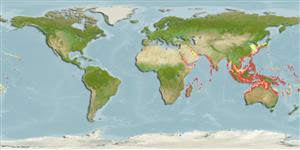Common names from other countries
>
Syngnathiformes (Pipefishes and seahorses) >
Syngnathidae (Pipefishes and seahorses) > Syngnathinae
Etymology: Hippocampus: Greek, ippos = horse + Greek,kampe = curvature (Ref. 45335).
More on author: Bleeker.
Environment: milieu / climate zone / depth range / distribution range
экология
морской; солоноватоводный ассоциированный с рифами; немигрирующий; пределы глубины 0 - 68 m (Ref. 37816), usually 0 - 8 m (Ref. 90102). Tropical; 39°N - 28°S, 32°E - 154°W (Ref. 57009)
Indo-Pacific: southern Africa, the Red Sea to Hawaii and French Polynesia; north to Japan, south to Australia.
Length at first maturity / Size / Вес / Возраст
Maturity: Lm 14.0 range ? - ? cm
Max length : 30.0 cm TL самец/пол неопределен; (Ref. 1602)
Краткое описание
определительные ключи | морфология | морфометрия
колючие лучи спинного плавника (общее число) : 0; членистые (мягкие) лучи спинного плавника (общее число) : 17 - 18; колючие лучи анального плавника: 0; членистые (мягкие) лучи анального плавника: 4.
Inhabit seagrass and marine algae areas of estuaries and seaward reefs; also on steep mud slopes. Found in open water and attached to drifting Sargassum up to 20 km from shore. Adults in pairs (Ref. 48635). Benthic to pelagic (Ref. 58302). Feeds on zooplankton (Ref. 85309). Ovoviviparous (Ref. 205). The males carry the eggs in a brood pouch which is found under the tail (Ref. 205). Not shown to be monogamous in the laboratory (Ref. 30915). Very popular aquarium fish. Highly valued species in traditional Chinese medicine (Ref. 30915). Has been reared in captivity (Ref. 35416).
There are 20 - 1000 larvae in incubating sacks; time of development is 20-28 days. The males carry the eggs in a brood pouch which is found under the tail (Ref. 205).
Lourie, S.A., R.A. Pollom and S.J. Foster, 2016. A global revision of the seahorses Hippocampus Rafinesque 1810 (Actinopterygii: Syngnathiformes): taxonomy and biogeography with recommendations for further research. Zootaxa 4146(1):1-66. (Ref. 115213)
Статус Красного Списка МСОП (Ref. 130435)
Угроза для людей
Harmless
Использование человеком
рыболовство: важный объект промысла; аквакультура (рыбоводство): коммерческий; аквариум: коммерческий
дополнительная информация
инструменты
Специальные отчеты
Скачать в формате XML
ресурсы в Интернет
Estimates based on models
Preferred temperature (Ref.
115969): 21.3 - 29, mean 27.8 (based on 1008 cells).
Phylogenetic diversity index (Ref.
82804): PD
50 = 0.5000 [Uniqueness, from 0.5 = low to 2.0 = high].
Bayesian length-weight: a=0.00447 (0.00177 - 0.01127), b=3.00 (2.78 - 3.22), in cm Total Length, based on LWR estimates for this (Sub)family-body shape (Ref.
93245).
Trophic level (Ref.
69278): 3.6 ±0.5 se; based on size and trophs of closest relatives
устойчивость к внешним воздействиям (Ref.
120179): средний (среднего размера), минимальное время удвоения популяции 1.4-4.4 года (tm=0.6; Fec=20-1000).
Fishing Vulnerability (Ref.
59153): Low vulnerability (15 of 100).
